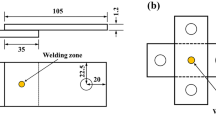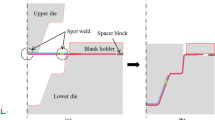Abstract
Hot stamping of patchwork blanks is flexible to adjust the mechanical properties of the component by applying patched blanks with different thicknesses and at different locations. Efficient process analysis needs a sophisticate finite element (FE) model for numerical simulation. A novel thermal–mechanical coupled FE model for hot stamping of patchwork blank was developed considering the thermal dependent failure of welding spots. The failure of the welding spots was evaluated by shear strength, which was characterized by tensile shear tests under different temperatures. Furthermore, the welding current and the arrangement of welding spots were determined to produce the patchwork blank. The locations and causes of forming defects, e.g. wrinkling and crack in hot stamping of a B-pillar with patchwork blanks, were analyzed. With numerical simulations and experimental investigations, the optimum process parameters were obtained. For predicting the thickness of typical sections and temperature distributions on the B-pillar for patchwork blank, the errors between numerical and experimental results were less than 10% in thickness distribution, and the maximum error was only 14.5% in temperature distribution. Experimental and simulation results show that the developed FE model is reliable and can be used to predict the results and improve the hot stamping process of patchwork blank.
Similar content being viewed by others
Reference
Karbasian H, Tekkaya AE (2010) A review on hot stamping. J Mater Process Technol 210(15):2103–2118
Merklein M, Johannes M, Lechner M, Kuppert A (2014) A review on tailored blanks—production, applications and evaluation. J Mater Process Technol 214(2):151–164
Merklein M, Wieland M, Lechner M, Bruschi S, Ghiotti A (2016) Hot stamping of boron steel sheets with tailored properties: a review. J Mater Process Technol 228:11–24
Klimek S (2008) Simulation of spot welds and weld seams of press-hardened steel (PHS) assemblies. LS-DYNA Anwenderforum, pp 21–28
Kashani HT (2015) Laser overlap welding of Zn-coated steel on aluminium alloy for patchwork blank applications in the automotive industry. Rev Adv Mater Sci 40(3):295–302
Beckmann M, Vollertsen F (2006) Analytical model for free form radii after deep and stretch drawing using pressurised membranes. J Mater Process Technol 174(1):363–370
Lamprecht K, Geiger M (2005) Characterisation of the forming behaviour of patchwork blanks. Steel Res Int 76(12):910–915
Liu H, Lei C, Xing Z (2013) Cooling system of hot stamping of quenchable steel BR1500HS: optimization and manufacturing methods. Int J Adv Manuf Technol 69(1–4):211–223
He B, Ying L, Li X, Hu P (2016) Optimal design of longitudinal conformal cooling channels in hot stamping tools. Appl Thermal Eng 106:1176–1189
Lamprecht K, Geiger M (2005) Experimental and numerical investigation of the formability of laser welded patchwork blanks. Adv Mater Res 6:689–696
Lamprecht, K., Merklein, M., Geiger, M. (2005) Hydroforming of patchwork blanks—numerical modeling and experimental validation. In NUMISHEET 2005: Proceedings of the 6th International Conference and Workshop on Numerical Simulation of 3 D Sheet Metal Forming Processes, Detroit, MI, USA, Part A: 526–531.
Al-Bahkali EA (2011) Load-displacement curves of spot welded, bonded, and weld-bonded joints for dissimilar materials and thickness. Bahkali 8(2):32–39
Ahmad MA, Zakaria A (2014) Optimization of spot-welds on patchwork blank for hot forming process. Appl Mechanics Mater 606:177–180
Hartmann, D., Wiemann, M., Sommer, A. (2010) Process for producing components having regions of differing ductility U.S. Patent Application No. 13/508: 288.
Xing ZW, Bao J, Yang YY (2009) Numerical simulation of hot stamping of quenchable boron steel. Mater Sci Eng A 499(1):28–31
Salvini P, Scardecchhia E, Demofonti G (1997) A procedure for fatigue life prediction of spot welded joints. Fatigue Fract Eng Mater Struct 20(8):1117–1128
Lamprecht, K., Merklein, M. (2004) Characterisation of mechanical properties of laser welded tailored and patchwork blanks. In Proceedings of the 4th International Conference on Laser Assisted Net Shape Engineering, Erlangen, DE.: 349–358.
Palmonella M, Friswell MI, Mottershead JE, Lees AW (2005) Finite element models of spot welds in structural dynamics: review and updating. Comput Struct 83(8):648–661
Lei C, Cui J, Xing Z, Fu H, Zhao H (2012) Investigation of cooling effect of hot-stamping dies by numerical simulation. Phys Procedia 25:118–124
Author information
Authors and Affiliations
Corresponding author
Rights and permissions
About this article
Cite this article
Lei, C., Xing, Z., Xu, W. et al. Hot stamping of patchwork blanks: modelling and experimental investigation. Int J Adv Manuf Technol 92, 2609–2617 (2017). https://doi.org/10.1007/s00170-017-0351-9
Received:
Accepted:
Published:
Issue Date:
DOI: https://doi.org/10.1007/s00170-017-0351-9




